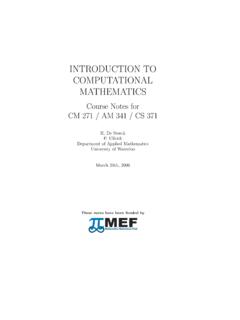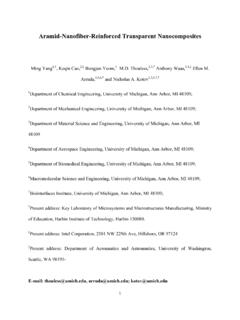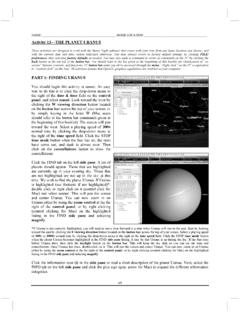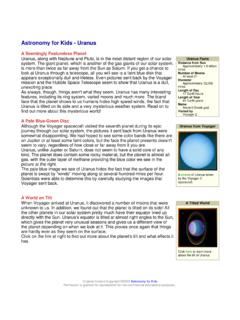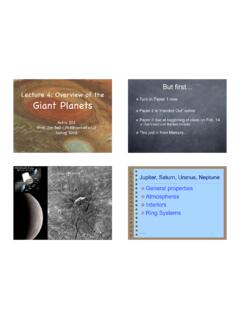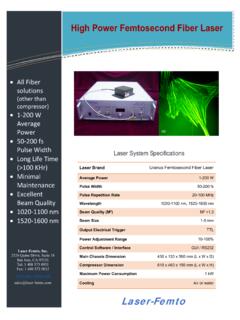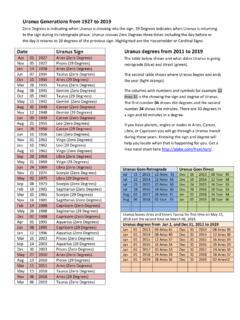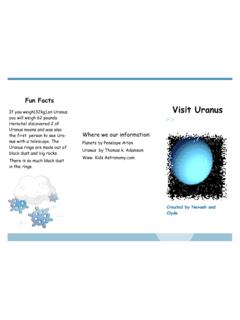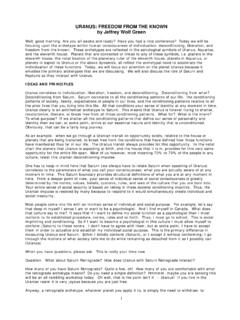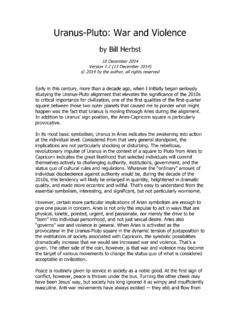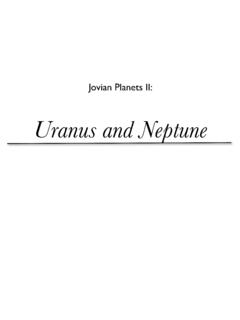Transcription of Ionospheric Models of Saturn, Uranus, and Neptune
1 TCARUS 24, 358--:~62 (1975) Ionospheric Models of saturn , uranus , and Neptune S. K. ATREYA t AND T. M. DONAHUE ~ Department of Physics, University of Pittsburgh, Pittsburgh, Pennsylvania 15260 Received September 6, 1974; revised November 4, 1974 model ionospheres are calculated for saturn , uranus , and Neptune . Protons are the maj or ions above 150 km altitude measured from a reference levelwhere the hydrogen density is 1 1016 molecules cm-a, while below 150 km quick conversion of protons to Ha + ions by a three-body association mechanism leads to a rapid removal of ionization in dissociative recombination of Ha +. Electron density maxima are found at about 260 km for saturn and uranus and 200 km for Neptune .
2 Present knowledge of the physical and chemical processes in the atmospheres of these planets suggests that their ionospheres probably will not be Jupiter-like. INTRODUCTION The Pioneer l0 radio occultation experi- ment has provided the first direct measure- ment of the electron density profile in the ionosphere of Jupiter (Kliore et al., 1974). The magnitude and location of the principal maximum in the electron density profile resemble closely the predictions made in the model ionospheres of Atreya et al. (1974). The maximum electron density is found to be nearly 5 105cm-3; nearly 400km above the level of the ammonia cloud tops. This level occurs about 220km above an assumed reference level where the hydrogen density is 1 10i6molecules cm -3, if we assume a cloud top density of about (7-8) 1019cm -3 (Giver et al.)
3 , 1969), an average temperature of about 140- 150K (Wallace et al., 1974) and abundance ratio of for He to H 2. In another paper in preparation we attempt to explain the discrepancies between the predictions and the measurements on the basis of Jovian dynamics and a peculiar electromagnetic interaction between Io and Jupiter (Goldreich and Lynden-Bell, 1969; Gurnett, 1972) which may result in relatively large concentrations of Io- related sodium ions (McElroy et al., 1974) in the lower ionosphere of Jupiter. On t Present affiliation: Department of Atmos- pheric and Oceanic Sciences, University of l~[ichigan, Ann Arbor, Michigan 48105. Copyright 1975 by Academic Press, Inc. All rights of reproduction in any form reserved.]
4 Printed in Great Britain others of the outer planets, however, magnetic fields have not been conclusively detected (Sonett, 1973) and no Io-Jupiter like planet-satellite interaction is known; therefore Ionospheric Models in these planets will not necessarily be similar to those measured by Pioneer 10 at Jupiter. Therefore, in the present paper we con- struct photochemical equilibrium Models of the ionospheres of saturn , uranus , and Neptune , the calculations being similar to those for Jupiter (Atreya et al., 1974). The implications of a possible Saturnian mag- netic field and of the nature of the rings are discussed. Models The model atmospheres used are the same as given by McElroy (1973) in which H 2 and He are the major constituents with minor quantities ofNH 3 and CH 4.
5 Ridgway (1974) has recently discovered other hydro- carbons: acetylene and ethane in the Jupiter's atmosphere, however their abun- dance is not large enough to play a direct role in determining the ionization. Photo- ionization of H 2, H, and He (pl, p2, pS, and p7) are the principal ion-production processes. The relative importance of the production processes in Table I are illustrated by McElroy (1973) in his Fig. 6. The chemical model listed in Table I is the same as for Jupiter (Atreya et al., 1974); 358 Ionospheric Models OF saturn , uranus AND Neptune TABLE I IMPORTANT REACTIONS I1,,1 THE IOI~OSPHERE OF THE OUTER PLANETS a 359 Reaction number Reaction Rate constant Reference Ion production : pl H 2 + hv --~ H2 + + e p2 --~ H+ + I-I + e p3 H 2 + e -+ H2 + + 2e p4 -~ H + + H + 2e p5 H+hv --~ H+ + e p6 H+e -~ H+ + 2e p7 He + hv --~ He + + e p8 He + e -~ He + + 2e Ion exchange : el H2 + + H 2 --> Ha + + H e2 H2 + -{-- H --~ H 2 -I- H + e3 He + + H 2 --~ He + H2 + e4 -+ Hell + + H e5 --> He + H + H + e6 H + -[.]}
6 - H 2 -{- H 2 ~ Ha + + H 2 e7 Hell + -{- H 2 --~ H3 + -[- He Ion removal/Electron-ion recombination: rl H3 + -'t- e ~ H2 - - H r2 H2+Te --> H + H r3 Hett+ + e --> He + H r4 H++e ---~ H + hv r5 He + + e --~ He + hv 2 x 10 -9 ~1 10 -1 20% sum 1 x 10 -13 > 80% 10 .29 x 10 .9 x 10 -7 < 1 x 10 -s ~1 x 10 -s x 10 -12 x 10 -12 McElroy (1973) Theard and Huntress (1974) Hunten (1969), Prasad and Gapone (1971) Johnsen and Biondi (1974) Miller et al. (1968) Theard and Huntress (1974) Leu et al. (1973) Hunten (1969), Prasad and Capone (1971) Hunten (1969), Prasad and Capone (1971) Bates and Dalgarno (1962) Bates and Dalgarno (1962) a The rate constants are in units of cm3sec -1 for two-body reactions, and cm6sec -1 for three-body reactions.]}}
7 Some reaction rates have, however, been brought up to date (that is to say, they have been measured). We emphasize the importance of the reactions (e6) and (e7) (I)algarno, 1971) neglected prior to our paper on the Jovian ionosphere (Atreya et al., 1974). Protons are efficiently removed via the three-body association reaction (e6) below about 150kin; and both reactions (e6) and (e7) result in an increased abundance of H3 + ions which are removed by the dis- sociative recombination reaction (rl). The recently measured value of the rate constant for (rl) is nearly a factor of 40 larger than used in the previous studies and the result is a much lower electron density in the lower ionosphere than will be found in earlier Models .
8 The electron density profile is found to be: quite'sensitive to the branching ratio of the reaction rates ]cs/k 3 + ]c a + ]c 5 ; and in the present study reaction k 5 is assumed to account for at least 80% of the total reaction rate (]c 3 + k 4 + k 5) in accordance with the recent measurements by Johnsen and Biondi (1974). model ionospheres for saturn , uranus , and Neptune calculated on the basis of photochemical equilibrium are shown in Figs. 1, 2, and 3. These Models differ from earlier Models in many respects: (i) ~60 ATREYA AND DONAHUE i i L i . saturn -~ ~oo" ""'" . 'K='zx,O' "~e] ~ ,, ,~ 3] 200 I00 .. I / I I I i01 i0 2 i0 ] i0 4 i0 5 i0 6 1or, Density (cm -s) Fro. 1. A model for saturn 's ionosphere with eddy diffusion coefficient, K = 2 x 106cm2sec -1, and He mixing ratio of Maximum computed values of [Hell+l, [He+], and [Hz +] ions are smaller than can be drawn on the scale of this figure.
9 The vertical scale gives the height above a reference levelwhere the H2 density is 1 x 1016 cm -3 . Protons are the majo r ions only above about 150km rather than throughout the entire ionosphere, (Ji) H3 + ions are domin- ant below 150km, (iii) unlike earlier Models , here the Hell + ion abundance is negligible, (iv) below 260km on saturn and uranus and below 200kin on Neptune , the electron density is as much as a factor 100 smaller than calculated in the earlier Models . The Ionospheric Models con- structed in Figs. 1, 2, and 3 are with He/H2= and eddy diffusion coef- ficient, K= 2 x 106cm2see, ~ ; the value of these parameters has not yet been con- clusively determined. The Models are found to be essentially independent of the.
10 uranus \ ':3_ 300 """ K= 2~,o ~ 200 ,oo.. / / I I I i01 i02 i03 104 i0 S i06 Ion Oensily (cm -s) ' FIG. 2. A model for uranus ' ionosphere, Notatioh as for Fig. 1. 300 Neptune ' ~,,.~N e ] K=2x,O ~ ZOO _o I00 I ]_ ; I i r i01 ij$ lO 5 i06 - lO ~ lot, Ce~si~ , (cm -3) FIG. 3. A model for Neptune 's ionosphere. Notation as for Fig. 1. choice of the He/H 2 abundance ratio which was varied between and 1 in these calculations. Changing K to l0 s, however changes the maximum electron density by nearly a factor of 3. The range of values selected for K is in accord with the recent Lyman-alpha measurements of Pioneer 10 (Judge and Carlson, 1974) and the Copern- icus satellite (Jenkins et al.)




